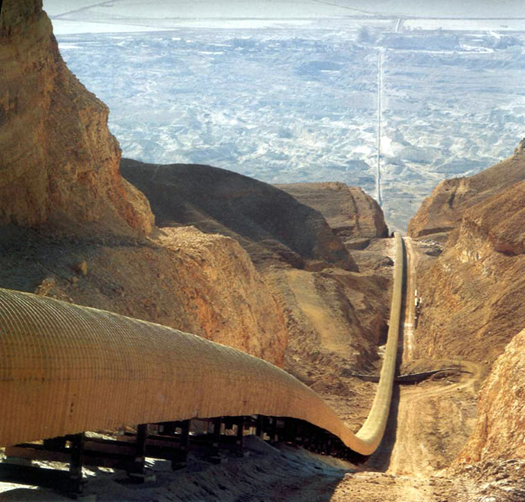
I was reminded of the Conveyor Belt for the Dead Sea Works (pictured above) by FASLANYC‘s post last week, which rightly notes that Israeli landscape architect Shlomo Aronson completed a small series of projects in the mid-eighties which prefigured the contemporary interest in landscape infrastructures. While the conveyor belt is an obviously sculptural (and beautiful) presence in the Rift Valley landscape, a more important concern for the invisible patterns of the Judean desert ecology drives the architecture of this infrastructure and makes the project significant as a case studio in the ability of an architect to enhance the ecological function of a large-scale infrastructure.
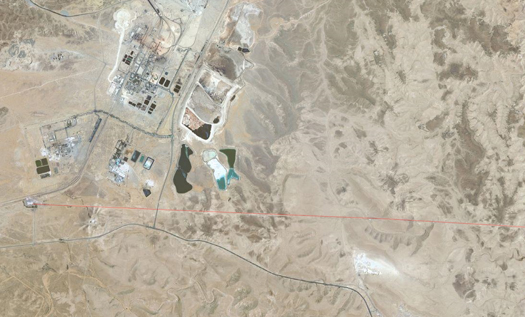
The conveyor belt, at 18 kilometers the third longest in the world (at least at the time of its design), was planned by the Dead Sea Works to convey over a million tons of potash each year from the extraction site (400 meters above sea level) to the Dead Sea Works’ main factory on the banks of the Dead Sea (400 meters below sea level). The belt replaced a “tortuous 39-kilometer truck route where 200 semi-trailers a day loaded with potash once clogged traffic, created a safety hazard, damaged the road, and spewed diesel fumes”. Israel’s Nature Reserves Authority at first opposed the project (which would span the entire South Judean Desert Nature Reserve, “known for the flora, wildlife, and archaeological sites of its unspoiled canyons and cliffs”), citing the fragility of the desert environment, but later approved it on the condition that the Dead Sea Works employed a landscape architect to design the conveyor belt.
Aronson redrew the planned belt route to avoid building unnecessary earthworks, while lengthening bridges to allow “free passage for hikers and desert animals”. Bridges, which also replaced earthworks wherever possible, were constructed by cranes perched either on the route of the belt or on previously built sections of the bridge, so as to minimize the impact of construction on the delicate desert ecology. Aronson required all work to be done within a narrow 10-meter construction corridor; this restriction was followed strictly, despite the need to move over a million tons of earth and to construct 12 bridges. The delicate steel bridges and the yellow ochre sheath of the conveyor were selected to simultaneously emphasize the lengthy infrastructure as a significant engineering feat while permitting the belt to complement, rather than overwhelm, the existing landscape.
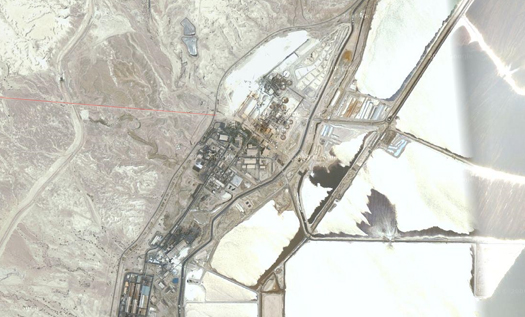
The conveyor belt, then, at both the local scale (bridges, earthworks, pylons) and the regional scale (the route) was constructed specifically to account for both visible aims (the preservation of the scenic value of the Syrian-African Rift Valley) and invisible aims (the free flow of wildlife, the avoidance of damage to local ecologies). It serves at once as a statement of the scale of human intervention in the Israeli landscape and as a statement of the possibility of designing that intervention so as not to detract from that environmentt, but to augment and emphasize the intrinsic beauty of the pre-existing landscape.

As fascinating and long as the belt is, though, it is a relatively minor infrastructure in comparison to the vast — eighteen miles long — Salt Ponds it feeds its cargo onto the shores of. And those Ponds perhaps present an opportunity for a much more substantial landscape intervention, one which would not merely seek to ameliorate the conditions produced by accepted industrial processes (as Aronson’s conveyor belt does so skillfully), but would look to fundamentally reorganize those processes. This difference of opportunity may serve to effectively highlight the difference between two possible answers to the question FASLANYC poses, “what value do landscape/architects add to the design of infrastructures?”, a question which mammoth has previously been concerned with.
The Dead Sea Works are a major global chemical producer, supplying in particular potassium — one of the three primary ingredients in chemical fertilizers — to over sixty countries on five continents. An article (part of a larger series entitled “Life from the Dead Sea”, which is worth reading if you’re intrigued by the Dead Sea) at WysInfo describes the production process:
The potassium in the Dead Sea is… produced at the Dead Sea Works by a process based on selective sedimentation of the non-required minerals in a system of evaporation ponds until the solutions of the desired composition are finally obtained.
For the construction of the ponds a system of dams was built which today encompasses the Israeli sector of the shallow southern basin of the sea, which is now in fact a vast evaporation pond.
At present, the water of the Dead Sea is pumped from the deep northern basin a distance of 400 meters and carried in a canal to the southern basin, into the ponds, where – through natural evaporation – the water loses 50% of its initial volume and kitchen salt and calcium chloride crystallize out into a second system of ponds. Here the carnallite, which is the raw material for producing potash, crystallizes and sediments. Potash is an impure form of potassium carbonate (K2CO3) mixed with other potassium salts. Potash has been used since ancient times as a fertilizer and in the manufacture of glass and soap.
This material is mechanically “harvested” from the bottom of the pools and pumped through pipes to the potash plant. Here the carnallite crystals are separated from the stock solution and washed in water to dissolve the magnesium chloride in the solution…
In order to add value to the relatively cheap raw materials (also including bromine, magnesium, and salt) harvested from the Dead Sea waters in the evaporation ponds, the Dead Sea Works refines the harvested potash into compound fertilizers, a process which multiplies the value of the chemicals ten-fold, but requires combining the Dead Sea potassium with “phosphate-rich sediments [found] to the west of the Dead Sea”, which are brought to the shores of the Salt Ponds on Aronson’s conveyor belt.
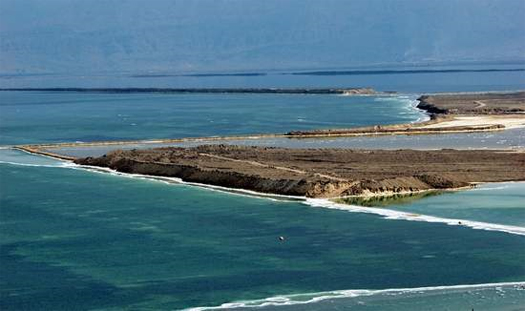
This chemical harvest produces a great deal of economic benefit for Israel, providing employment to thousands and being the primary way in which Israel benefits from the mineral wealth of the Dead Sea (which is the largest concentration of accessible mineral within the country’s borders — estimated at 1.9 billion tons of potassium chloride and as much as 44 billion tons of salt), but the continuous diversion of mineral-laden water from the northern basin of the Dead Sea south into the evaporation ponds is exacerbating the already perilous shrinkage of the Sea.
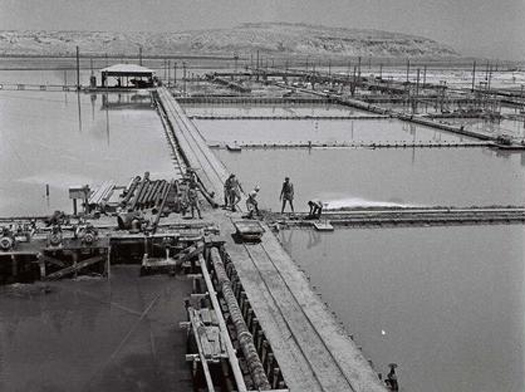
An article in Smithsonian magazine from 2005 explains the history of the Dead Sea and how it came to enter its current state of rapid decline:
Created by the same shift of tectonic plates that formed the Syrian-African Rift Valley several million years ago, the Dead Sea owes its precarious state to both human and geological factors. Originally part of an ancient, much larger lake that extended to the Sea of Galilee, its outlet to the sea evaporated some 18,000 years ago, leaving a salty residue in a desert basin at the lowest point on earth—1,300 feet below sea level. Since then, this body of water, known as the Dead Sea since Greco-Roman times, has maintained its equilibrium through a fragile natural cycle: it gets fresh water from rivers and streams from the mountains that surround it and loses it by evaporation. The evaporation process, combined with its rich salt deposits, account for its extraordinary—up to 33 percent—salinity (compared with the up to 27 percent salinity of Utah’s Great Salt Lake). Until the 1950s, the flow of fresh water equaled the rate of evaporation, and Dead Sea water levels held steady. Then in the 1960s, Israel built an enormous pumping station on the banks of the Sea of Galilee, diverting water from the upper Jordan, the Dead Sea’s prime source, into a pipeline system that supplies water throughout the country. To make matters worse, in the 1970s Jordan and Syria began diverting the Yarmouk, the lower Jordan River’s main tributary.
Since then, the Dead Sea has declined dramatically. It needs an infusion of 160 billion gallons of water annually to maintain its current size; it gets barely 10 percent of that. Some 50 miles long in 1950, the sea is about 30 miles long today. Water levels are falling at an average rate of three feet per year. According to a recent Israeli government study, the rate of evaporation will slow and the Dead Sea will reach equilibrium again in a few decades—but not before losing another third of its present volume.
Ironically, though the northern basin is imperiled by retreating water levels, posh hotels along the industrialized southern basin of the Dead Sea are besieged by rising water levels produced by the deposition of waste salts, which lifts the bed of the southern basin approximately seven inches a year, causing the hotels to surround themselves with sand dikes and plan for a leisure lagoon, cordoned off from the industrial ponds. At the northern end, hotels obviously have the opposite problem: the beach is racing away from their doors, so hotels employ tractors and wagons to ferry tourists from their rooms to the banks of the Sea. The declining overall volume of the Sea is also emptying the surrounding freshwater aquifers, producing over a thousand gaping sinkholes in the past fifteen years, as retreating freshwater dissolves underground salt deposits. Together with increased erosion, the sinkholes have destroyed roads, date palm orchards, and buildings, producing a landscape sufficiently unstable to lead the Israeli government to proclaim a development freeze in the vicinity of the Sea. Complex oasis ecosystems which belie the Sea’s moniker by supporting vibrant communities of flora and fauna, including five hundred million migratory birds who stop at the Dead Sea between Africa and Europe, are similarly threatened.
This environmental and economic catastrophe is by no means solely the result of the industrial processes employed at the Dead Sea Works, but the evaporation ponds do contribute significantly to the draining of the northern basin (by one estimate, approximately a quarter of the yearly shrinkage is attributable to the Dead Sea Works).

In a watershed as water-poor as that of the Jordan River, increased conservation alone will not be able to reduce freshwater demands to levels which could reverse the shrinking of the Dead Sea, though there is no doubt that increased conversation is necessary.
Given that reality, a number of serious large-scale engineering proposals to reverse the drainage of the Dead Sea exist, including two plans for massive canals linking the Dead Sea to larger waterbodies which could replenish it — the Red Sea to the south and the Mediterranean to the west, as well as the development of mass-scale desalination plants which could supply fresh water to replace that taken from the Jordan and its tributaries, potentially affording the opportunity to let the Jordan run freely into the Dead Sea again.
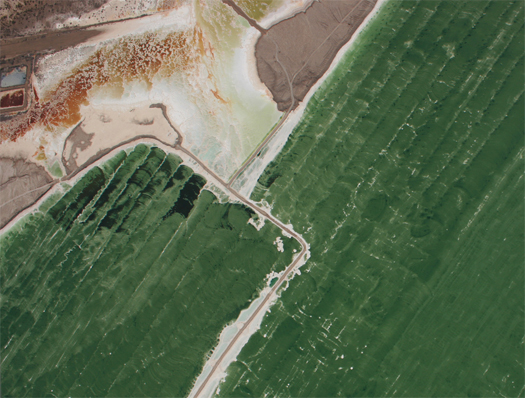
But perhaps what is needed is not merely a new set of mega-infrastructures, diverting water across deserts from other watersheds (and doing so in a manner which is potentially quite dangerous), but a re-configuration of the industrial processes at work in the Dead Sea, a re-shaping of the industrial landscape to create positive feedbacks into biological systems? One might easily believe that the Dead Sea is exactly the sort of industrialized and urbanized “bio-physical system” which Pierre Belanger has argued (PDF) can only be understood and dealt with at a watershed-scale:
Endogenous and exogenous processes, such as eutrophication, combined-sewer overflow, sediment contamination, invasive flora, exotic fauna, depleted water reserves, and seasonal floods can no longer be perceived as isolated incidents but rather as a part of a large, constructed hydrological ecology that is entirely and irreversibly connected to the process of urbanization…
What form a landscape infrastructure for the revitalization of the Dead Sea might take is difficult to say; perhaps the Dead Sea Works might be inspired by their success at producing salt from salt water, and try their hand at separating out the other component in that raw ingredient, augmenting the salt ponds and fertilizer-production facilities on the southern basin with networks of desalinization plants, capitalizing (as the ponds do, through evaporation) on the plentiful solar energy of the Negev to power those plants. Or perhaps, like Orange County, a far-sighted municipality could construct a string of wastewater recycling plants and recharge the freshwater aquifers surrounding the Sea, halting the spread of erosion and sinkholes. Whatever the form, agriculture, industry, wastewater systems, and natural ecologies could be viewed not as competing interests vying over a singular and shrinking water supply, but as necessary components of a single regional urban ecology, with waste flows from one component providing the raw material for the processes of others.
Quotations in this post related to the conveyor belt are derived from both an article, “Desert Conveyance”, which ran in Landscape Architecture in April 1991 and Aronson’s monograph, Making Peace with the Land. I’m afraid that I didn’t record which quotations came from which source when I originally took them down several years ago; related to the larger question of the Dead Sea Works, doubts linger about the long-term sustainability of any regional economy based on phosphorous production or application: read Infranet Lab on “peak phosphorous” and further background on “peak phosphorous” in this article by Melinda Burns (via @bldgblog), which includes the suggestion by a scientist that “there’s a whole industry that needs to be invented to capture phosphorus” — perhaps a further clue to what a re-invented Dead Sea Works might look like, as the phosphate waste products of farming, as well as the urban sewage choking the Jordan, could become the raw material for industry and the water wasted by industry the lifeblood of agriculture and a reinvigorated Dead Sea.


Thanks for this. It does seem like the Works offers a great opportunity for implementing Kalundborg style approach to industrial/regional scale ecologies..
yes, an interesting run down. it seems there are several projects/research articles in that last paragraph.
this: “But perhaps what is needed is not merely a new set of mega-infrastructures” combined with your last sentence is provocative.
and yet, one question- the dead sea works are outputting materials for ecologies/economies far away. it seems at odds to then suggest that they should be able to handle this output without an equal input from afar, does it not? Looking at it as a smaller system (region watershed) operating within a larger, fundamentally different system (world wide industrial agriculture).
It’s like the eart spinning on its axis and rotating around the sun all while hurtling through space and somehow that is all in balance.. wha? I’ll stop.
Given FASLANYC’s previously stated interest in labor, I thought I’d note that I see a direct link between re-industrialization (my current favorite catch-all term for things which are post-20th-century-industrial, but not passively post-industrial like most of the 1990s post-industrialism) and opportunity for labor to flourish; or, design for re-industrialization is design for labor. That’s what’s most intriguing about re-industrial landscapes and industrial ecologies like Kalundborg: that they retain the sense of the landscape as a productive place, not a museum of previously vital economies for the amusement of knowledge workers and tourists (though I am, of course, in both of the latter categories, I’d like to think that I’m capable of appreciating interests beyond my own). While I think FASLANYC may have been talking more about labor as an alternative to the deployment of capital in the production of landscapes, I think the points remain related.
[…] noted before Pierre Belanger’s predictions about the bio-physical landscape as infrastructure, which he […]
[…] has been discussed in other blogs how infrastructures shapes our cities and landscapes and how their presence is important to understand them. Following […]
[…] “what value do landscape/architects add to the design of infrastructures?” and was followed by Rob and Stephen at mammoth’s the dead sea works. It can be continued […]
[…] Bou Craa conveyor, which is similar to the Negev desert belt previously discussed on mammoth, carries phosphate across the desert in Western Sahara, leaving the wind-swept sediment […]
… track backe bei http://kermitprecissi.manablog.jp/ ……
excellent , votre blog site design est certainement nice , Je suis recherche pour un nouveau thème pour mon moncler doudoune propre site web , j’aime vôtre, maintenant Je vais à aller cherchez le exacte même disposition style !…
[…] one point to another and is full of examples on large scale projects like oil pipelines such as the Conveyor Belt for the Dead Sea, which also includes, among the pipeline, bridges, earthworks and pylons.But at this point, in the […]
[…] one point to another and is full of examples on large scale projects like oil pipelines such as the Conveyor Belt for the Dead Sea, which also includes, among the pipeline, bridges, earthworks and […]